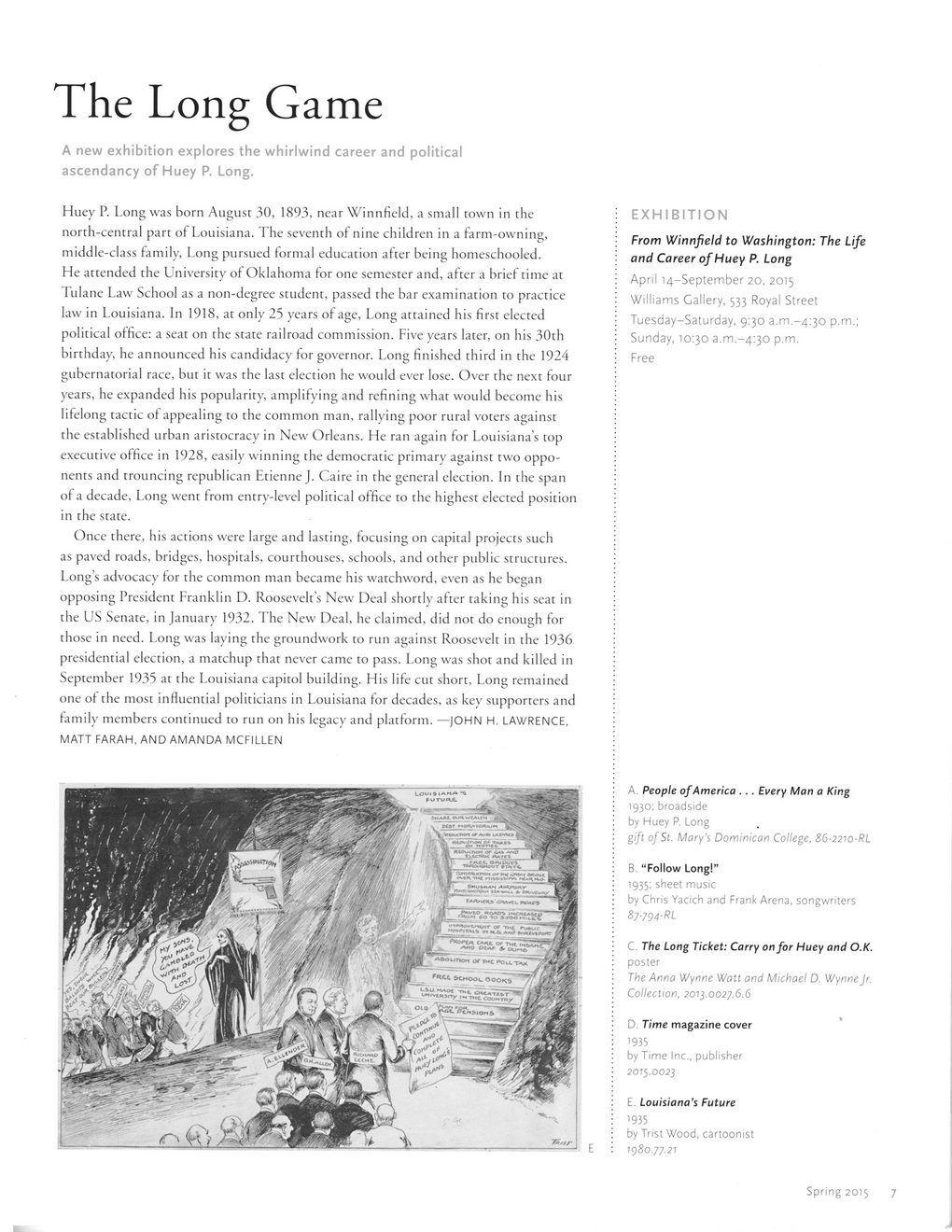This text was obtained via automated optical character recognition.
It has not been edited and may therefore contain several errors.
The Long Game A new exhibition explores the whirlwind career and political ascendancy of Huey P. Long. Huey P. Long was born August 30, 1893, near Winnfield, a small town in the north-central part of Louisiana. The seventh of nine children in a farm-owning, middle-class family, Long pursued formal education after being homeschooled. He attended the University of Oklahoma for one semester and, after a brief time at Tulane Law School as a non-degree student, passed the bar examination to practice law in Louisiana. In 1918, at only 25 years of age, Long attained his first elected political office: a seat on the state railroad commission. Five years later, on his 30th birthday, he announced his candidacy for governor. Long finished third in the 1924 gubernatorial race, but it was the last election he would ever lose. Over the next four years, he expanded his popularity, amplifying and refining what would become his lifelong tactic of appealing to the common man, rallying poor rural voters against the established urban aristocracy in New Orleans. He ran again for Louisiana’s top executive office in 1928, easily winning the democratic primary against two opponents and trouncing republican Etienne J. Caire in the general election. In the span of a decade, Long went from entry-level political office to the highest elected position in the state. Once there, his actions were large and lasting, focusing on capital projects such as paved roads, bridges, hospitals, courthouses, schools, and other public structures. Long’s advocacy for the common man became his watchword, even as he began opposing President Franklin D. Roosevelt’s New Deal shortly after taking his seat in the US Senate, in January 1932. The New Deal, he claimed, did not do enough for those in need. Long was laving the groundwork to run against Roosevelt in the 1936 presidential election, a matchup that never came to pass. Long was shot and killed in September 1935 at the Louisiana capitol building. His life cut short, Long remained one of the most influential politicians in Louisiana for decades, as key supporters and family members continued to run on his legacy and platform. —JOHN H. LAWRENCE, MATT FARAH, AND AMANDA MCFILLEN EXHIBITION From Winnfield to Washington: The Life and Career of Huey P. Long April 14-September 20, 2015 Williams Gallery, 533 Royal Street Tuesday-Saturday, 9:30 a.m.-4:30 p.m.; Sunday, 10:30 a.01.-4:30 p.m. Free A People of America .. . Every Man a King 1930: broadside by Huey P. Long gift of St. Mary's Dominican College, 86-2210-RL B. “Follow Long!” 1935: sheet music by Chris Yacich and Frank Arena, songwriters 87794- RL C The Long Ticket: Carry on for Huey and O.K. poster The Anna Wynne Watt and Michael D. Wynne Jr. Collection, 2073.0027.6.6 D Time magazine cover 1935 by Time Inc., publisher 2015.0023 E Louisiana's Future 1935 by Trist Wood, cartoonist 19S0.77.21 Spring 2015 7

New Orleans Quarterly 2015 Spring (09)